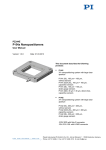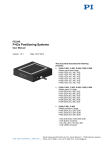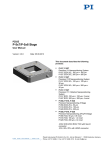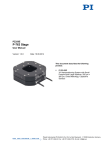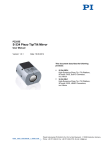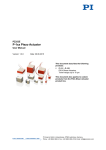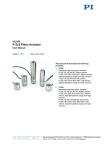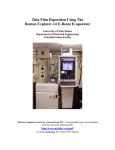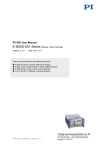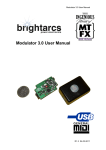Download User Manual PZ253 - Physik Instrumente
Transcript
PZ253E P-611 Positioning Systems User Manual Version: 1.0.0 Date: 24.07.2014 This document describes the following products: P-611.1 Linear Piezo Positioning System P-611.1S/.10 P-611.XZ / P-611.2 XZ and XY Nanopositioner P-611.2S/.20/.XZS/.XZ0 P-611.3 NanoCube® XYZ Piezo Stage P-611.3S/.3SF/.3O/.3OF P-611.Z Piezo Z Stage P-611.ZS/.Z0 .1S/.10/.2S/.20/.XZS/.XZ0/.ZS/.Z0 = with LEMO connector(s) .3S/.3SF/.3O/.3OF = with Sub-D connector Physik Instrumente (PI) GmbH & Co. KG, Auf der Roemerstr. 1, 76228 Karlsruhe, Germany Phone: +49 721 4846-0, Fax: +49 721 4846-1019, E-mail: [email protected] Physik Instrumente (PI) GmbH & Co. KG is the owner of the following trademarks: PI®, PIC®, PICMA®, PILine®, PIFOC®, PiezoWalk®, NEXACT®, NEXLINE®, NanoCube®, NanoAutomation®, Picoactuator®, PInano® The products described in this document are in part protected by the following patents: German patent no. 10021919C2 German patent no. 10234787C1 German patent no. 10348836B3 German patent no. 102005015405B3 German patent no. 102007011652B4 US patent no. 7,449,077 Japanese patent no. 4667863 Chinese patent no. ZL03813218.4 © 2014 Physik Instrumente (PI) GmbH & Co. KG, Karlsruhe, Germany. The text, photographs and drawings in this manual are protected by copyright. With regard thereto, Physik Instrumente (PI) GmbH & Co. KG retains all the rights. Use of said text, photographs and drawings is permitted only in part and only upon citation of the source. Original instructions First printing: 24.07.2014 Document number: PZ253E, CBo, Version 1.0.0 Subject to change without notice. This manual is superseded by any new release. The latest release is available for download (p. 3) on our website. Contents 1 About this Document 1.1 1.2 1.3 1.4 1.5 2 3 Goal and Target Audience of this User Manual ...................................................1 Symbols and Typographic Conventions ...............................................................1 Figures ..................................................................................................................2 Other Applicable Documents ................................................................................3 Downloading Manuals ..........................................................................................3 Safety 2.1 2.2 2.3 5 Intended Use ........................................................................................................5 General Safety Instructions ..................................................................................6 Organizational Measures ......................................................................................8 Product Description 3.1 3.2 3.3 3.4 3.5 3.6 1 9 Model Overview ....................................................................................................9 Product View.......................................................................................................10 Product Labeling .................................................................................................12 Scope of Delivery ...............................................................................................14 Suitable Electronics ............................................................................................14 Technical Features .............................................................................................15 3.6.1 PICMA® Piezo Actuators .................................................................15 3.6.2 Flexure Guides .................................................................................15 3.6.3 Strain Gauge Sensors (SGS) ...........................................................16 4 Unpacking 17 5 Installation 19 5.1 5.2 5.3 5.4 6 General Notes on Installation .............................................................................19 Connecting the P611 to the Protective Earth Conductor ..................................21 Mounting the P611 ............................................................................................23 Affixing the Load .................................................................................................25 Start-Up and Operation 6.1 6.2 6.3 29 General Notes on Start-Up and Operation .........................................................29 Operating the P611 ...........................................................................................31 Discharging the P611 ........................................................................................31 7 Maintenance 7.1 7.2 33 General Notes on Maintenance ..........................................................................33 Cleaning the P611 .............................................................................................33 8 Troubleshooting 35 9 Customer Service 37 10 Technical Data 39 10.1 10.2 10.3 10.4 Specifications......................................................................................................39 10.1.1 Data Table ........................................................................................39 10.1.2 Maximum Ratings .............................................................................43 10.1.3 Ambient Conditions and Classifications ...........................................44 Dimensions .........................................................................................................45 Torque for Stainless Steel Screws (A2-70) ........................................................52 Pin Assignment ...................................................................................................52 11 Old Equipment Disposal 55 12 EC Declaration of Conformity 57 1 About this Document 1 About this Document In this Chapter Goal and Target Audience of this User Manual ............................................................ 1 Symbols and Typographic Conventions ........................................................................ 1 Figures ........................................................................................................................... 2 Other Applicable Documents ......................................................................................... 3 Downloading Manuals ................................................................................................... 3 1.1 Goal and Target Audience of this User Manual This user manual contains the necessary information for the intended use of the P611 (x stands for the different models, see p. 9). Basic knowledge of control technology, drive technologies and suitable safety measures is assumed. The latest versions of the user manuals are available for download (p. 3) on our website. 1.2 Symbols and Typographic Conventions The following symbols and typographic conventions are used in this user manual: CAUTION Dangerous situation If not avoided, the dangerous situation will result in minor injury. Actions to take to avoid the situation. NOTICE Dangerous situation If not avoided, the dangerous situation will result in damage to the equipment. Actions to take to avoid the situation. P-611 Positioning Systems PZ253E Version: 1.0.0 1 1 About this Document INFORMATION Information for easier handling, tricks, tips, etc. Symbol/ Label Meaning 1. Action consisting of several steps whose sequential order must be observed 2. Action consisting of one or several steps whose sequential order is irrelevant List item p. 5 Cross-reference to page 5 RS-232 Labeling of an operating element on the product (example: socket of the RS-232 interface) Warning signs affixed to the product that refer to detailed information in this manual. 1.3 Figures For better understandability, the colors, proportions and degree of detail in illustrations can deviate from the actual circumstances. Photographic illustrations may also differ and must not be seen as guaranteed properties. 2 Version: 1.0.0 PZ253E P-611 Positioning Systems 1 About this Document 1.4 Other Applicable Documents The devices and software tools which are mentioned in this documentation are described in their own manuals. The latest versions of the user manuals are available for download (p. 3) on our website. Device Document E-501 modular piezo controller PZ62E User Manual E-503 piezo amplifier module PZ62E User Manual E-509 sensor / servo controller module PZ77E User Manual E-515 display module PZ62E User Manual E-517 interface and display module PZ214E User Manual E-564 piezo controller Technical Note E564T0001 E-610 piezo amplifier / servo controller PZ70E User Manual E-621 servo controller module PZ115E User Manual E-625 piezo servo controller PZ166E User Manual E-660 piezo amplifier PZ45E User Manual E-663 piezo amplifier PZ69E User Manual E-664 NanoCube® piezo controller PZ99E User Manual E-665 servo controller PZ127E User Manual PIMikroMove SM148E Software Manual P-5xx / P-6xx / P-7xx piezo positioning systems PZ240EK Short Instructions 1.5 Downloading Manuals INFORMATION If a manual is missing or problems occur with downloading: Contact our customer service department (p. 37). P-611 Positioning Systems PZ253E Version: 1.0.0 3 1 About this Document INFORMATION For some products (e.g. Hexapod systems and electronics that are delivered with a CD), access to the manuals is password-protected. The password is stored on the CD. Availability of the manuals: Password-protected manuals: FTP download directory Follow the corresponding instructions for downloading. Freely available manuals: PI website Download freely accessible manuals 1. Open the website http://www.pi-portal.ws. 2. Click Downloads. 3. Click the corresponding product category. 4. Go to the corresponding product code. The available manuals are displayed. 5. Click the desired manual and save it on the hard disk of your PC or on a data storage medium. Download password-protected manuals 1. Insert the product CD in the PC drive. 2. Switch to the Manuals directory on the CD. 3. In the Manuals directory, open the Release News (file including releasenews in the file name). 4. Find the user name and the password in the section "User login for software download" in the Release News. 5. Open the FTP download directory (ftp://pi-ftp.ws). − Windows operating systems: Open the FTP download directory in Windows Explorer. 6. Log in with the user name and the password from the Release News. 7. In the directory of the corresponding product, go to the Manuals sub-directory. 8. Copy the desired manual to the hard disk of your PC or to a data storage medium. 4 Version: 1.0.0 PZ253E P-611 Positioning Systems 2 Safety 2 Safety In this Chapter Intended Use ................................................................................................................. 5 General Safety Instructions ........................................................................................... 6 Organizational Measures............................................................................................... 8 2.1 Intended Use The P611 is a laboratory device as defined by DIN EN 61010-1. It is intended to be used in interior spaces and in an environment which is free of dirt, oil, and lubricants. Based on its design and realization, the P611 is intended for fine positioning as well as the fast and precise motion of small objects. The specifications of the P611 apply to horizontal mounting. The motion is performed as follows depending on the model: Model Motion Axis .1S/.10 in one axis horizontally X .2S/.20 in two axes horizontally X, Y .XZS/.XZ0 in one axis horizontally and in one axis vertically X, Z .3S/.3SF/.3O/.3OF in two axes horizontally and in one axis vertically X, Y, Z .ZS/.Z0 in one axis vertically Z Vertical mounting is only possible under certain conditions. The intended use of the P611 is only possible in combination with suitable electronics (p. 14) that is available from PI. The electronics is not included in the scope of delivery of the P611. The electronics must provide the required operating voltages. To ensure proper performance of the servo-control system, the electronics must also be able to read out and process the signals from the position sensors. P-611 Positioning Systems PZ253E Version: 1.0.0 5 2 Safety 2.2 General Safety Instructions The P611 is built according to state-of-the-art technology and recognized safety standards. Improper use can result in personal injury and/or damage to the P611. Only use the P611 for its intended purpose, and only use it if it is in a good working order. Read the user manual. Immediately eliminate any faults and malfunctions that are likely to affect safety. The operator is responsible for the correct installation and operation of the P611. The P611 is driven by piezo actuators. Temperature changes and compressive stresses can induce charges in piezo actuators. After being disconnected from the electronics, piezo actuators can also stay charged for several hours. Touching or short-circuiting the contacts in the connector of the P611 can lead to minor injuries. In addition, the piezo actuators can be destroyed by an abrupt contraction. Do not open the P611. Discharge the piezo actuators of the stage before installation: Connect the stage to the switched-off PI controller, which is equipped with an internal discharge resistor. Do not pull out the connector from the electronics during operation. For stages with Sub-D connector: Touching the contacts in the connector can lead to an electric shock (max. 130 V DC) and minor injuries. Do not touch the contacts in the connector. Secure the connector of the stage with screws against being pulled out of the controller. 6 Version: 1.0.0 PZ253E P-611 Positioning Systems 2 Safety If a protective earth conductor is not or not properly connected, dangerous touch voltages can occur on the P611 in the case of malfunction or failure of the system. If touch voltages exist, touching the P611 can result in minor injuries from electric shock. Connect the P611 to a protective earth conductor (p. 21) before start-up. Do not remove the protective earth conductor during operation. If the protective earth conductor has to be removed temporarily (e. g. in the case of modifications), reconnect the P611 to the protective earth conductor before starting it up again. Mechanical forces can damage or misalign the P611. Avoid impacts that affect the P611. Do not drop the P611. Do not exceed the maximum permissible stress and load capacities according to the specifications (p. 39). Only hold the P611 by the holding surfaces of the base body (p. 17). The P611 is maintenance-free and achieves its positioning accuracy as a result of the optimum alignment of mechanical components and piezo actuators. Loosened screws cause a loss in positioning accuracy. Only loosen screws according to the instructions in this manual. Do not open the P611. P-611 Positioning Systems PZ253E Version: 1.0.0 7 2 Safety 2.3 Organizational Measures User manual Always keep this user manual available by the P611. The latest versions of the user manuals are available for download (p. 3) on our website. Add all information given by the manufacturer to the user manual, for example supplements or Technical Notes. If you pass the P611 on to other users, also turn over this user manual as well as other relevant information provided by the manufacturer. Only use the device on the basis of the complete user manual. Missing information due to an incomplete user manual can result in minor injury and property damage. Only install and operate the P611 after having read and understood this user manual. Personnel qualification The P611 may only be installed, started up, operated, maintained and cleaned by authorized and appropriately qualified personnel. 8 Version: 1.0.0 PZ253E P-611 Positioning Systems 3 Product Description 3 Product Description In this Chapter Model Overview ............................................................................................................. 9 Product View ............................................................................................................... 10 Product Labeling .......................................................................................................... 12 Scope of Delivery ........................................................................................................ 14 Suitable Electronics ..................................................................................................... 14 Technical Features ...................................................................................................... 15 3.1 Model Overview The following standard versions of the P611 are available: P-611.1: Linear Piezo Positioning System Model Description P-611.1S Linear nanopositioning system, 100 µm, strain gauge sensor P-611.10 Linear nanopositioning system, 120 µm, open-loop P-611.XZ / P-611.2: XZ and XY Nanopositioner Model Description P-611.2S XY nanopositioning system, 100 µm × 100 µm, strain gauge sensors P-611.20 XY nanopositioning system, 100 µm × 100 µm, open-loop P-611.XZS XZ nanopositioning system, 100 µm × 100 µm, strain gauge sensors P-611.XZ0 XZ nanopositioning system, 100 µm × 100 µm, open-loop P-611.3: NanoCube® XYZ Piezo Stage Model Description P-611.3S NanoCube® XYZ nanopositioning system, 100 µm × 100 µm × 100 µm, strain gauge sensors P-611 Positioning Systems PZ253E Version: 1.0.0 9 3 Product Description Model Description P-611.3SF NanoCube® XYZ nanopositioning system, 100 µm × 100 µm × 100 µm, strain gauge sensors, integrated fiber holder P-611.3O NanoCube® XYZ nanopositioning system, 100 µm × 100 µm × 100 µm, open-loop P-611.3OF NanoCube® XYZ nanopositioning system, 100 µm × 100 µm × 100 µm, open-loop, integrated fiber holder P-611.Z: Piezo Z Stage Model Description P-611.ZS Vertical nanopositioning stage, 100 µm, strain gauge sensor P-611.Z0 Vertical nanopositioning stage, 110 µm, open-loop 3.2 Product View The figures serve as examples and can differ from your stage model. Figure 1: Example of product view 10 1 Moving platform 2 Base body 3 Protective earth connection 4 Cable exit Version: 1.0.0 PZ253E P-611 Positioning Systems 3 Product Description Directions of motion of the P-611 The arrows each represent the positive direction of motion. P-611.1x P-611.Zx P-611.2x P-611.XZx P-611.3x / P-611.3xF P-611 Positioning Systems PZ253E Version: 1.0.0 11 3 Product Description 3.3 Product Labeling Figure 2: P-611: Position of the product labeling (example of a view from above) Labeling Description Model-Dependent Position Model Triangular arrow with the letter X Positive direction of motion of the .1x / .XZx X axis .2x B .3x / .3xF D Triangular arrow with the letter Y Positive direction of motion of the .2x Y axis .3x / .3xF C Triangular arrow with the letter Z Positive direction of motion of the .Zx Z axis .XZx C NanoCube® WWW.PI.WS P-611.XZS 12 Position Version: 1.0.0 C A D .3x / .3xF A Brand name .3x / .3xF D Manufacturer's logo .2Sx A Other models D Manufacturer's address (website) .2Sx Product name (example), the places after the point refer to the model PZ253E A Other models D .2Sx A Other models D P-611 Positioning Systems 3 Product Description Labeling Description 114031266 Serial number (example), individual for each P611 Model-Dependent Position Model Position .2Sx: A Other models D .2Sx A Other models D .2Sx A Other models D .2Sx A Other models D .2Sx A Other models D .2Sx A Other models B Meaning of the places (counting from left): 1 = internal information 2 and 3 = manufacturing year 4 to 9 = consecutive numbers Country of origin: Country of origin Germany Warning sign "Observe manual!" Old equipment disposal (p. 55) CE conformity mark Symbol for the protective earth conductor, marks the protective earth connection of the P611 Figure 3: P-611: "Residual voltage" warning sign on connector Warning sign "Residual voltage": Notice of risk of electric shock (p. 6) P-611 Positioning Systems PZ253E Version: 1.0.0 13 3 Product Description 3.4 Scope of Delivery Order Number Components P611 Stage according to order (p. 9) 000036450 M4 screw set for protective earth, consisting of: PZ240EK 1 M4x8 flat-head screw with cross recess, ISO 7045 2 safety washers 2 flat washers Short instructions for piezo positioning systems 3.5 Suitable Electronics To operate a P611, you need suitable electronics. Devices are selected depending on the type of application. The following table lists suitable devices (x = suitable). Channels Electronics P-611 Model .1S .ZS .10 .Z0 .2S .20 .3S .3O .XZS .XZ0 .3SF .3OF E-610 piezo amplifier / servo controller, OEM module 1 x x x* E-625 piezo servo controller (bench-top) 1 x x x* x* E-665 servo controller (bench-top) 1 x E-621 servo controller module 1 x x* x* E-660 piezo amplifier (bench-top) 1 E-501 modular piezo controller, consisting of: 3 x* x* x* x x x x x E-503 piezo amplifier module Only models with sensor: E-509.S3N sensor / servo controller module Optional: E-517 interface and display module or E-515 display module 14 Version: 1.0.0 PZ253E P-611 Positioning Systems 3 Product Description Electronics Channels P-611 Model .1S .ZS E-564 3-channel piezo controller with digital interface 3 E-664 NanoCube® piezo controller 3 E-663 piezo amplifier (bench-top) 3 .10 .Z0 .2S .20 .3S .3O .XZS .XZ0 .3SF .3OF x x x x x x * One device per axis 3.6 Technical Features 3.6.1 PICMA® Piezo Actuators P611 stages are driven by PICMA® piezo actuators. PICMA® actuators have all-ceramic insulation and are therefore far superior to conventional actuators in respect to performance and lifetime. The monolithic piezoceramic block is protected against humidity and failure due to increased leakage current by a ceramic insulation layer. In this way, an especially high reliability is achieved even under extreme ambient conditions. In contrast to motorized drives, there are no rotating parts or friction. The piezo actuators are therefore backlash-, maintenance- and wear-free. 3.6.2 Flexure Guides P611 stages have flexure guides (flexures) for frictionless motion and high guiding accuracies. A flexure guide is an element which is free from static and sliding friction. It is based on the elastic deformation (bending) of a solid (e.g. steel) and does not have any rolling or sliding parts. Flexure elements have a high stiffness and load capacity. Flexure guides are maintenance- and wear-free. They are 100 % vacuum compatible, function in a wide temperature range and do not require any lubricants. P-611 Positioning Systems PZ253E Version: 1.0.0 15 3 Product Description 3.6.3 Strain Gauge Sensors (SGS) Strain gauge sensors derive the position information from their expansion. They are attached at a suitable position in the drivetrain, where they measure the displacement of the moving stage part against the base body. This type of position measurement is done with contact and indirectly, since the position of the moving platform is derived from a measurement on the lever, guide or piezo stack. The sensors are equipped with a full-bridge circuit that is insensitive to thermal drift, and assure optimum position stability in the nanometer range. 16 Version: 1.0.0 PZ253E P-611 Positioning Systems 4 Unpacking 4 Unpacking NOTICE Mechanical overload from incorrect handling! Impermissible mechanical loading of the moving platform as well as certain surfaces of the P611 can lead to damage to the piezo actuators, sensors and flexure joints of the P611 as well as to loss of accuracy. In addition, the P611 can be damaged from tensile forces on the cable exit and bending of the connection cable. Only hold the P611 by the holding surfaces of the base body (p. 17). Avoid tensile forces on the cable exit and do not bend the cable. The figure serves as an example and can differ from your stage model. Figure 4: P-611: Holding surfaces to be used on the base body (see arrows) Areas to be protected against the application of forces: - Moving platform (framed with a dashed line) - Non-anodized surfaces (hatched) 1. Unpack the P611 carefully: a) b) c) d) Spread the foam packaging apart with one hand. Grasp the stage by the holding surfaces. Grasp all connection cables of the stage with your other hand. Carefully remove the stage and the connection cables from the foam packaging at the same time. P-611 Positioning Systems PZ253E Version: 1.0.0 17 4 Unpacking 2. Compare the contents against the items covered by the contract and against the packing list. 3. Inspect the contents for signs of damage. If there is any sign of damage or missing parts, contact PI immediately. 4. Keep all packaging materials in case the product needs to be returned. 18 Version: 1.0.0 PZ253E P-611 Positioning Systems 5 Installation 5 Installation In this Chapter General Notes on Installation ...................................................................................... 19 Connecting the P611 to the Protective Earth Conductor ........................................... 21 Mounting the P611 ..................................................................................................... 23 Affixing the Load .......................................................................................................... 25 5.1 General Notes on Installation CAUTION Dangerous voltage and residual charge on piezo actuators! The P611 is driven by piezo actuators. Temperature changes and compressive stresses can induce charges in piezo actuators. After being disconnected from the electronics, piezo actuators can also stay charged for several hours. Touching or short-circuiting the contacts in the connector of the P611 can lead to minor injuries. In addition, the piezo actuators can be destroyed by an abrupt contraction. Do not open the P611. Discharge the piezo actuators of the stage before installation: Connect the stage to the switched-off PI controller, which is equipped with an internal discharge resistor. Do not pull out the connector from the electronics during operation. For stages with Sub-D connector: Touching the contacts in the connector can lead to an electric shock (max. 130 V DC) and minor injuries. Do not touch the contacts in the connector. Secure the connector of the stage with screws against being pulled out of the controller. P-611 Positioning Systems PZ253E Version: 1.0.0 19 5 Installation NOTICE Mechanical overload from incorrect handling! Impermissible mechanical loading of the moving platform as well as certain surfaces of the P611 can lead to damage to the piezo actuators, sensors and flexure joints of the P611 as well as to loss of accuracy. In addition, the P611 can be damaged from tensile forces on the cable exit and bending of the connection cable. Only hold the P611 by the holding surfaces of the base body (p. 17). Avoid tensile forces on the cable exit and do not bend the cable. NOTICE Damage from unsuitable cables! Unsuitable cables can damage the stage and the electronics. Only use cables provided by PI for connecting the P611 to the electronics. NOTICE Damage from incorrect mounting! Incorrect mounting of the P611 or incorrectly mounted parts can damage the P611. Only mount the P611 and the loads on the mounting fixtures (holes) intended for this purpose. NOTICE Damage due to incorrectly tightened screws! Incorrectly tightened screws can cause damage. Observe the torque range (p. 52) given for the screws used during installation. INFORMATION Extended cables can reduce the positioning accuracy of the P611 or affect the sensor processing by the electronics. 20 Do not use cable extensions. If you need longer cables, contact our customer service department (p. 37). Version: 1.0.0 PZ253E P-611 Positioning Systems 5 Installation 5.2 Connecting the P-611 to the Protective Earth Conductor INFORMATION In the case of P611 stages with Sub-D connectors, ground loops can occur when the stage is grounded via its protective earth connector as well as by the shield of the connection cable for the electronics. If a ground loop occurs, contact our customer service department (p. 37). INFORMATION Observe the applicable standards for mounting the protective earth conductor. The P611 has an M4 hole for mounting the protective earth conductor. This hole is marked with the symbol for the protective earth conductor of the hole, see "Dimensions" (p. 45). . For the precise position Prerequisite You have read and understood the general notes on installation (p. 19). The stage is not connected to the electronics. Tools and accessories Suitable protective earth conductor: Cross-sectional area of the cable 2 ≥0.75 mm Supplied M4 protective earth screw set (p. 14) for connecting the protective earth conductor Suitable screwdriver P-611 Positioning Systems PZ253E Version: 1.0.0 21 5 Installation Figure 5: Mounting of the protective earth conductor (profile view) 1 Base body of the P-611 2 Flat washer 3 Safety washer 4 Screw 5 Cable lug 6 Protective earth conductor Connecting the P-611 to the protective earth conductor 1. If necessary, fasten a suitable cable lug to the protective earth conductor. 2. Fasten the cable lug of the protective earth conductor using the M4 screw on the protective earth connection of the P611 as shown in the profile view. 3. Tighten the M4 screw with a torque of 1.2 Nm to 1.5 Nm. 4. Make sure that the contact resistance at all connection points relevant for mounting the protective earth conductor is <0.1 Ω at 25 A. 22 Version: 1.0.0 PZ253E P-611 Positioning Systems 5 Installation 5.3 Mounting the P-611 NOTICE Warping of the P-611 due to mounting on uneven surfaces! Mounting the P611 on an uneven surface can warp the P611. Warping reduces the accuracy. Mount the P611 on an even surface. The recommended evenness of the surface is ≤20 µm. For applications with great temperature changes: Only mount the P611 on surfaces that have the same or similar thermal expansion properties as the P611. NOTICE Tensile stress on piezo actuator with vertical mounting! When the stage is mounted vertically, tensile stress can result in particular alignments that reduces the preload of the piezo actuator and thus destroys it. If you want to mount the P611 vertically, contact our customer service department (p. 37). NOTICE Protruding screw heads! Protruding screw heads can damage the P611. Ensure that the screw heads do not protrude from counter-sunk holes so that they do not interfere with the stage motion. The following figures serve as examples and can differ from your stage model. P-611 Positioning Systems PZ253E Version: 1.0.0 23 5 Installation Figure 6: P-611.1x and .2x: Holes for mounting the stage on a surface Number of mounting holes: P-611.1x: 4 P-611.2x: 3 Figure 7: P-611.XZx, .3x, .3xF and .Zx: One of four recesses in the base body Prerequisite You have read and understood the general notes on installation (p. 19). Tools and accessories When mounting a P611.2x: − When mounting other models of the P611: − 24 3 screws of suitable size and length (p. 45) 4 screws of suitable size and length (p. 45) Suitable screwdriver Version: 1.0.0 PZ253E P-611 Positioning Systems 5 Installation Mounting the stage on a surface 1. Position the stage on an even surface. 2. Introduce the screws: When mounting a P611.1x or .2x: − Introduce the screws into the counter-sunk holes in the base body of the P611 from above. When mounting a P611.XZx, .3x, .3xF or .Zx: − Introduce the screws into the recesses in the base body of the P611 from the side. 3. Tighten the screws. Observe the specified torque range (p. 52) while doing so. 5.4 Affixing the Load NOTICE Mechanical overload due to high torques and high loads! When affixing the load, high torques and high loads can overload the moving platform of the P611. Mechanical overload can cause damage to the piezo actuators, sensors and flexure joints of the P611 and lead to losses in accuracy. Observe the torque range (p. 52) given for the screws used during installation. Avoid torques >50Ncm on the moving platform. Do not exceed the maximum permissible stress and load capacities according to the specifications (p. 39). NOTICE Warping of the P-611 due to affixing of loads with uneven contact surface! Affixing loads with an uneven contact surface can warp the P611. Warping reduces the accuracy. Only affix loads on the P611 whose contact surface with the moving platform of the stage has an evenness of at least 20 μm. For applications with great temperature changes: Only affix loads on the P611 that have the same or similar thermal expansion properties as the P611. P-611 Positioning Systems PZ253E Version: 1.0.0 25 5 Installation NOTICE Center of load at unsuitable position! If the center of load is located far outside of the moving platform (e. g. high set-ups and long levers), the P611 can be damaged from high strain on the flexure guides, high torques and oscillations. If the center of the load to be affixed is far above or to the side of the moving platform, adjust the controller settings before start-up or contact our customer service department (p. 37). NOTICE Screws that are too long! The P611 can be damaged by screws that are too long. Note the depth of the mounting holes in the moving platform (p. 45). Only use screws of the correct length for the respective mounting holes. INFORMATION The positive direction of motion of the axes is given in the product view (p. 10). Center of load at the optimum position: Figure 8: Example of an optimally affixed load 26 Version: 1.0.0 PZ253E P-611 Positioning Systems 5 Installation Center of load at an unsuitable position: Figure 9: High set-up and center of load far above the moving platform Figure 10: Long lever and center of load on the side of the moving platform Prerequisite You have read and understood the general notes on installation (p. 19). Tools and accessories Screws of appropriate size and length (p. 45) Suitable tools Affixing the load Only affix loads to the threaded holes (p. 45) intended for this purpose and with suitable screws. Observe the specified torque range (p. 52) while doing so. Affix the load so that it is centered and that the center of load is on the moving platform. P-611 Positioning Systems PZ253E Version: 1.0.0 27 6 Start-Up and Operation 6 Start-Up and Operation In this Chapter General Notes on Start-Up and Operation .................................................................. 29 Operating the P611 .................................................................................................... 31 Discharging the P611 ................................................................................................. 31 6.1 General Notes on Start-Up and Operation CAUTION Risk of electric shock if the protective earth conductor is not connected! If a protective earth conductor is not or not properly connected, dangerous touch voltages can occur on the P611 in the case of malfunction or failure of the system. If touch voltages exist, touching the P611 can result in minor injuries from electric shock. Connect the P611 to a protective earth conductor (p. 21) before start-up. Do not remove the protective earth conductor during operation. If the protective earth conductor has to be removed temporarily (e. g. in the case of modifications), reconnect the P611 to the protective earth conductor before starting it up again. NOTICE Destruction of the piezo actuator by electric flashovers! The use of the P611 in environments that increase the electrical conductivity can lead to the destruction of the piezo actuator by electric flashovers. Electric flashovers can be caused by moisture, high humidity, liquids and conductive materials such as metal dust. In addition, electric flashovers can also occur in certain air pressure ranges due to the increased conductivity of the air. Avoid operating the P611 in environments that can increase the electric conductivity. Only operate the P611 within the permissible ambient conditions and classifications (p. 44). P-611 Positioning Systems PZ253E Version: 1.0.0 29 6 Start-Up and Operation NOTICE Reduced lifetime of the piezo actuator due to permanently high voltage! The permanent application of a high static voltage to piezo actuators leads to a considerable reduction in the lifetime of the piezo ceramics of the actuator. When the P611 is not used but the controller remains switched on to ensure temperature stability, discharge the P611 (p. 31). NOTICE Operating voltage too high or incorrectly connected! Operating voltages that are too high or incorrectly connected can cause damage to the P611. Only operate the P611 with controllers/drivers and original accessories from PI. Do not exceed the operating voltage range (p. 43) for which the P611 is specified. Only operate the P611 when the operating voltage is properly connected; see "Pin Assignment" (p. 52). NOTICE Uncontrolled oscillation! Oscillations can cause irreparable damage to the stage. Oscillations are indicated by a humming and can result from the following causes: A change in the load and/or dynamics requires the servo-control parameters to be adjusted. The stage is operated near its resonant frequency. If you notice oscillations: In closed-loop operation, immediately switch off the servo mode. In open-loop operation, immediately stop the stage. INFORMATION The positive direction of motion of the axes is given in the product view (p. 10). INFORMATION Sound and vibration (e.g. footfall, impacts) can be transmitted to the stage and can affect its performance with regard to position stability. 30 Avoid transmitting sound and vibration while the stage is being operated. Version: 1.0.0 PZ253E P-611 Positioning Systems 6 Start-Up and Operation 6.2 Operating the P-611 Follow the instructions in the manual of the controller used for start-up and operation of the P611. 6.3 Discharging the P-611 The P611 must be discharged in the following cases: Before installation Before demounting (e.g. before cleaning and transporting the P611 and for modifications) If the P611 is not used but the controller remains switched on to ensure temperature stability The P611 is discharged through the internal discharge resistor of the controller from PI. Discharging a P-611 that is connected to the controller In closed-loop operation: 1. Switch off the servo mode on the controller. 2. Set the piezo voltage to 0 V on the controller. In open-loop operation: Set the piezo voltage to 0 V on the controller. Discharging a P-611 that is not connected to the controller Connect the stage to the switched-off controller from PI. P-611 Positioning Systems PZ253E Version: 1.0.0 31 7 Maintenance 7 Maintenance In this Chapter General Notes on Maintenance ................................................................................... 33 Cleaning the P611 ...................................................................................................... 33 7.1 General Notes on Maintenance NOTICE Misalignment from loosening screws! The P611 is maintenance-free and achieves its positioning accuracy as a result of the optimum alignment of mechanical components and piezo actuators. Loosened screws cause a loss in positioning accuracy. Only loosen screws according to the instructions in this manual. Do not open the P611. 7.2 Cleaning the P-611 Prerequisites You have discharged the piezo actuators of the P611 (p. 31). You have disconnected the P611 from the controller. Cleaning the P-611 Clean the surfaces of the P611 with a cloth that is slightly dampened with a mild cleanser or disinfectant (e.g. ethanol or isopropanol). Do not do any ultrasonic cleaning. P-611 Positioning Systems PZ253E Version: 1.0.0 33 8 Troubleshooting 8 Troubleshooting Problem Possible Causes Solution No or limited motion The cable is not connected correctly Check the cable connections. Excessive load Do not exceed the maximum permissible stress and load capacities according to the specifications (p. 39). Zero shift of the sensor for the following reasons: Perform a zero-point adjustment of the sensor (see controller manual). Only mount the P611 on surfaces with the following characteristics: Reduced accuracy Load applied in direction of motion Ambient/operating temperature of the stage far above or below calibration temperature (21°C to 24°C) Warping of the base body or the moving platform Evenness of at least 20 μm The thermal expansion properties are similar to those of the P611 (e. g. surfaces made of aluminum). Only affix loads with the following characteristics on the P611: − − − − P-611 Positioning Systems PZ253E The contact surface of the load has an evenness of at least 20 μm. The thermal expansion properties are similar to those of the P611 (e. g. loads made of aluminum). Version: 1.0.0 35 8 Troubleshooting Problem Possible Causes Solution P611 or controller has been replaced After the P611 or controller has been replaced, it is necessary to recalibrate the axis displacement. Axes were mixed up during connection (only with LEMO connectors) Perform a recalibration of the axis displacement (see controller manual) or contact our customer service department (p. 37). Observe the assignment of the axes when connecting the stage to the controller. This assignment is indicated by labels on the devices. The stage is not connected to the corresponding controller (only with several systems) The stage starts oscillating or positions inaccurately Servo-control parameters incorrectly set because e. g. the load was changed Observe the assignment of the devices when several systems are connected. The assignment is indicated on the calibration label of the controller (see rear panel or bottom side), which contains the serial number of the stage to be connected. 1. Immediately switch off the servo mode of the corresponding stage axes. 2. Check the settings of the servocontrol parameters on the controller. 3. Adjust the servo-control parameters on the controller according to the load change. Open-loop operation near the resonant frequency In open-loop operation, only operate the stage with a frequency that is below the resonant frequency. If the problem that occurred with your system is not listed in the table above or cannot be solved as described, contact our customer service department (p. 37). 36 Version: 1.0.0 PZ253E P-611 Positioning Systems 9 Customer Service 9 Customer Service For inquiries and orders, contact your PI sales engineer or send us an e-mail ([email protected]). If you have questions concerning your system, have the following information ready: Product codes and serial numbers of all products in the system Firmware version of the controller (if present) Version of the driver or the software (if present) Operating system on the PC (if present) The latest versions of the user manuals are available for download (p. 3) on our website. P-611 Positioning Systems PZ253E Version: 1.0.0 37 10 Technical Data 10 Technical Data In this Chapter Specifications .............................................................................................................. 39 Dimensions .................................................................................................................. 45 Torque for Stainless Steel Screws (A2-70) ................................................................. 52 Pin Assignment ............................................................................................................ 52 10.1 Specifications 10.1.1 Data Table Active axes Motion and positioning Integrated sensor Open-loop travel, -20 to +120 V Closed-loop travel Open-loop resolution Closed-loop resolution Linearity error, closed-loop Repeatability Pitch Yaw Flatness Mechanical properties Stiffness in motion direction Unloaded resonant frequency Resonant frequency @ 30 g Resonant frequency @ 100 g Push / pull force capacity in motion direction Load capacity Drive properties Ceramic type Electrical capacitance Dynamic operating current coefficient Miscellaneous Operating temperature range Material Dimensions Mass Cable length Voltage connection Sensor connection P-611.1S X P-611.10 X Unit Tolerance SGS 120 120 µm min. (20 % / -0 %) 100 0.2 2 0.1 <10 ±5 ±20 10 0.2 ±5 ±20 10 µm nm nm % nm µrad µrad nm typ. typ. typ. typ. typ. typ. typ. 0.2 400 300 195 15 / 10 0.2 400 300 195 15 / 10 N/µm Hz Hz Hz N ±20 % ±20 % ±20 % ±20 % max. 15 15 N max. PICMA® P-885 1.5 1.9 PICMA® P-885 1.5 1.9 µF µA/(Hz × µm) ±20 % ±20 % -20 to 80 Aluminum, steel 44 mm × 44 mm × 17 mm 0.135 1.5 LEMO LEMO -20 to 80 Aluminum, steel 44 mm × 44 mm × 17 mm 0.135 1.5 LEMO - °C kg m ±5 % ±10 mm The resolution of PI piezo nanopositioning systems is not limited by friction or stiction. Value given is noise equivalent motion with E-503 amplifier. Dynamic operating current coefficient in µA per Hz and µm. Example: Sine operation with 50 µm at 10 Hz requires approximately 0.9 mA of current. P-611 Positioning Systems PZ253E Version: 1.0.0 39 10 Technical Data Active axes Motion and positioning Integrated sensor Open-loop travel, -20 to 120 V Closed-loop travel Open-loop resolution Closed-loop resolution Linearity error Repeatability Pitch in X, Y Runout θX (motion in Z) Yaw in X Yaw in Y Runout θY (motion in Z) Mechanical properties Stiffness Resonant frequency, no load Resonant frequency, under load, at 30 g Resonant frequency, under load, at 100 g Push / pull force capacity in motion direction Load capacity Drive properties Ceramic type Electrical capacitance Dynamic operating current coefficient Miscellaneous Operating temperature range Material Dimensions Mass Cable length Sensor connection Voltage connection P-611.2S X, Y P-611.20 X, Y P-611.XZS X, Z P-611.XZ0 X, Z Unit Tolerance SGS 120 – 120 SGS 120 – 120 µm min. (20 % / -0 %) 100 0.2 2 0.1 <10 ±5 – ±20 ±10 – – 0.2 – – – ±5 – ±20 ±10 – 100 0.2 2 0.1 <10 ±5 ±10 ±20 – ±10 – 0.2 – – – ±5 ±10 ±20 – ±10 µm nm nm % nm µrad µrad µrad µrad µrad typ. typ. typ. typ. typ. typ. typ. typ. typ. 0.2 0.2 0.2 Z: 0.35 X: 365; Z: 340 X: 280; Z: 295 X: 185; Z: 230 15 / 10 N/µm ±20 % X: 345; Y: 270 X: 270; Y: 225 X: 180; Y: 165 15 / 10 0.2 Z: 0.35 X: 365; Z: 340 X: 280; Z: 295 X: 185; Z: 230 15 / 10 X: 345; Y: 270 X: 270; Y: 225 X: 180; Y: 165 15 / 10 Hz ±20 % Hz ±20 % Hz ±20 % N max. 15 15 15 15 N max. PICMA® P-885 1.5 1.9 PICMA® P-885 1.5 1.9 PICMA® P-885 1.5 1.9 PICMA® P-885 1.5 1.9 -20 to 80 -20 to 80 -20 to 80 -20 to 80 Aluminum, steel 44 mm × 44 mm × 25 mm 0.235 1.5 LEMO LEMO Aluminum, steel 44 mm × 44 mm × 25 mm 0.235 1.5 – LEMO Aluminum, steel 44 mm × 44 mm × 34 mm 0.27 1.5 LEMO LEMO Aluminum, steel 44 mm × 44 mm × 34 mm 0.27 1.5 – LEMO µF ±20 % µA / (Hz ±20 % × µm) °C kg m ±5 % ±10 mm The resolution of PI piezo nanopositioning systems is not limited by friction or stiction. Value given is noise equivalent motion with E-503 amplifier. Dynamic operating current coefficient in µA per Hz and µm. Example: Sine operation with 50 µm at 10 Hz requires approximately 0.9 mA of current. 40 Version: 1.0.0 PZ253E P-611 Positioning Systems 10 Technical Data Active axes Motion and positioning Integrated sensor Open-loop travel, -20 to 120 V Closed-loop travel Open-loop resolution Closed-loop resolution Linearity error Repeatability Pitch in X, Y Runout θX (motion in Z) Yaw in X Yaw in Y Runout θY (motion in Z) Mechanical properties Stiffness Unloaded resonant frequency X/Y/Z Resonant frequency at 30 g in X/Y/Z Resonant frequency at 100 g in X / Y / Z Push / pull force capacity in motion direction Load capacity Drive properties Ceramic type Electrical capacitance Dynamic operating current coefficient Miscellaneous Operating temperature range Material Dimensions Mass Cable length Sensor connection Voltage connection P-611.3S P-611.3SF X, Y, Z P-611.3O P-611.3OF X, Y, Z Unit Tolerance SGS 120 / axis 120 / axis µm min. (20 % / -0%) 100 / axis 0.2 1 0.1 <10 ±5 ±10 ±20 ±10 ±10 – 0.2 – – – ±5 ±10 ±20 ±10 ±10 µm nm nm % nm µrad µrad µrad µrad µrad typ. typ. typ. typ. typ. typ. typ. typ. typ. 0.3 350 / 220 / 250 0.3 350 / 220 / 250 N/µm Hz ±20 % ±20 % 270 / 185 / 230 270 / 185 / 230 Hz ±20 % 180 / 135 / 200 180 / 135 / 200 Hz ±20 % 15 / -10 15 / -10 N max. 15 15 N max. PICMA® P-885 1.5 1.9 PICMA® P-885 1.5 1.9 µF µA/(Hz × µm) ±20 % ±20 % -20 to 80 Aluminum, steel 48 mm × 44 mm × 43.2 mm SF version: 44 mm × 50 mm × 44.2 mm 0.32 1.5 Sub-D connector Sub-D connector -20 to 80 °C Aluminum, steel 44 mm × 44 mm × 43.2 mm OF version: 44 mm × 50 mm × 44.2 mm 0.32 kg 1.5 m – Sub-D connector ±5 % ±10 mm The resolution of PI piezo nanopositioning systems is not limited by friction or stiction. Value given is noise equivalent motion with E-503 amplifier. Dynamic operating current coefficient in µA per Hz and µm. Example: Sine operation with 50 µm at 10 Hz requires approximately 0.9 mA of current. Adapter cable with LEMO connectors for sensor and operating voltage available. P-611 Positioning Systems PZ253E Version: 1.0.0 41 10 Technical Data P-611.ZS P-611.Z0 Active axes Z Z Motion and positioning Integrated sensor Open-loop travel, -20 to +120 V SGS 120 Closed-loop travel Open-loop resolution Closed-loop resolution Linearity error Repeatability Runout θZ (Z motion) Runout θX (Z motion) Runout θY (Z motion) Mechanical properties Stiffness Unloaded resonant frequency Resonant frequency @ 30 g Resonant frequency @ 100 g Push / pull force capacity Drive properties Ceramic type Electrical capacitance Dynamic operating current coefficient Miscellaneous Operating temperature range Material Dimensions Mass Cable length Sensor connection Voltage connection Unit Tolerance 120 µm min. (20% / -0%) 100 0.2 2 0.1 <10 ±5 ±20 ±5 0.2 ±5 ±20 ±5 µm nm nm % nm µrad µrad µrad typ. typ. typ. typ. typ. typ. typ. 0.45 460 375 265 15 / 10 0.45 460 375 265 15 / 10 N/µm Hz Hz Hz N ±20 % ±20 % ±20 % ±20 % max. PICMA® P-885 1.5 1.9 PICMA® P-885 1.5 1.9 µF µA/(Hz × µm) ±20 % ±20 % -20 to 80 Aluminum, steel 44 mm × 44 mm × 27 mm 176 1.5 LEMO LEMO -20 to 80 Aluminum, steel 44 mm × 44 mm × 27 mm 176 1.5 LEMO LEMO °C g m ±5 % ±10 mm The resolution of PI piezo nanopositioning systems is not limited by friction or stiction. Value given is noise equivalent motion with E-503 amplifier. System properties System configuration: P-611.ZS and E-665.SR controller with 30 g load Small signal bandwidth: 40 Hz Settling time (10 % step width): 25 ms 42 Version: 1.0.0 PZ253E P-611 Positioning Systems 10 Technical Data 10.1.2 Maximum Ratings P611 stages are designed for the following operating data: Stage Maximum Operating Voltage Maximum Operating Maximum Power Frequency (Unloaded) Consumption P-611.1S -20 to +120 V 133 Hz 3.9 W -20 to +120 V 115 Hz (in X) 3.4 W (in X) P-611.20 90 Hz (in Y) 2.6 W (in Y) P-611.XZS -20 to +120 V 122 Hz (in X) 3.6 W (in X) P-611.XZ0 113 Hz (in Z) 3.3 W (in Z) 117 Hz (in X) 3.4 W (in X) P-611.3SF 73 Hz (in Y) 2.1 W (in Y) P-611.3O 83 Hz (in Z) 2.4 W (in Z) 153 Hz 4.5 W P-611.10 P-611.2S P-611.3S -20 to +120 V P-611.3OF P-611.ZS -20 to +120 V P-611.Z0 P-611 Positioning Systems PZ253E Version: 1.0.0 43 10 Technical Data 10.1.3 Ambient Conditions and Classifications The following ambient conditions and classifications must be observed for the P611: Area of application For indoor use only Maximum altitude 2000 m Air pressure 1100 hPa to 0.1 hPa (corresponds to roughly 825 Torr to 0.075 Torr) Relative humidity Highest relative humidity 80 % for temperatures up to 31 °C Decreasing linearly to 50 % relative humidity at 40 °C 44 Operating temperature –20 °C to 80 °C Storage temperature –20 °C to 80 °C Transport temperature –25 °C to 85 °C Overvoltage category II Protection class I Degree of pollution 1 Degree of protection according to IEC 60529 IP20 Version: 1.0.0 PZ253E P-611 Positioning Systems 10 Technical Data 10.2 Dimensions Dimensions in mm. Note that the decimal places are separated by a comma in the drawings. Figure 11: P-611.1S P-611 Positioning Systems PZ253E Version: 1.0.0 45 10 Technical Data Figure 12: P-611.10 46 Version: 1.0.0 PZ253E P-611 Positioning Systems 10 Technical Data Figure 13: P-611.2S and P-611.20 P-611 Positioning Systems PZ253E Version: 1.0.0 47 10 Technical Data Figure 14: P-611.XZS and P-611.XZ0 48 Version: 1.0.0 PZ253E P-611 Positioning Systems 10 Technical Data Figure 15: P-611.3O, P-611.3S, P-611.3OF and P-611.3SF P-611.3O P-611.3S P-611.3OF P-611.3SF P-611 Positioning Systems A 44 44 44 48 B 38.2 38.2 38.2 40 C 37.8 37.8 37.8 40 D 43.2 43.2 44.2 44.2 E 3 3 PZ253E F 2 2 G 3.5 3.5 3.5 4.1 H 44 44 50 50 J 40 40 Version: 1.0.0 K 3.5 3.5 3.5 19 L 10 10 10 13 49 10 Technical Data Figure 16: P-611.ZS 50 Version: 1.0.0 PZ253E P-611 Positioning Systems 10 Technical Data Figure 17: P-611.Z0 P-611 Positioning Systems PZ253E Version: 1.0.0 51 10 Technical Data 10.3 Torque for Stainless Steel Screws (A2-70) Screw Size Minimum Torque Maximum Torque M6 4 Nm 6 Nm M5 2.5 Nm 3.5 Nm M4 1.5 Nm 2.5 Nm M3 0.8 Nm 1.1 Nm M2.5 0.3 Nm 0.4 Nm M2 0.15 Nm 0.2 Nm M1.6 0.06 Nm 0.12 Nm 10.4 Pin Assignment Sub-D 25 connector Only for P-611.3S/.3SF/.3O/.3OF: Figure 18: Sub-D 25 connector: Front side with connections Pin assignment of the Sub-D 25 connector of the P-611.3S/.3SF 52 Pin Signal Function 1 Output SGS 3-B1 sensor signal 2 Input SGS 3 reference voltage 3 Output SGS 2-B1 sensor signal 4 Input SGS 2 reference voltage 5 Output SGS 3-B1 sensor signal Version: 1.0.0 PZ253E P-611 Positioning Systems 10 Technical Data Pin Signal Function 6 Input SGS 1 reference voltage 7 to 10 Free – 11 Input Piezo voltage +, channel 3 12 Input Piezo voltage +, channel 2 13 Input Piezo voltage +, channel 1 14 Output SGS 3-B2 sensor signal 15 GND SGS 3 GND 16 Output SGS 2-B2 sensor signal 17 GND SGS 2 GND 18 Output SGS 1-B2 sensor signal 19 GND SGS 1 GND 20 to 22 Free – 23 Input Piezo voltage –, channel 3 24 Input Piezo voltage –, channel 2 25 Input Piezo voltage –, channel 1 Pin assignment of the Sub-D 25 connector of the P-611.3O/.3OF Pin Signal Function 1 to 10 Free – 11 Input Piezo voltage +, channel 3 12 Input Piezo voltage +, channel 2 13 Input Piezo voltage +, channel 1 14 to 22 Free – 23 Input Piezo voltage –, channel 3 24 Input Piezo voltage –, channel 2 25 Input Piezo voltage –, channel 1 P-611 Positioning Systems PZ253E Version: 1.0.0 53 10 Technical Data LEMO connectors Only for P-611.1S/.10/.2S/.20/.XZS/.XZ0/.ZS/.Z0 Figure 19: LEMO connector (side view) LEMO connectors according to model (one connector per axis) P-611 Model 54 Connector (Front View) Pin Signal Function Connector Shell .1S / .10 PZT .2S / .20 .XZS / .XZ0 .ZS / .Z0 Inner conductor Input Piezo voltage –20 to 120 V Ground .1S / .2S / .XZS / .ZS 1 Input Supply voltage for Cable strain gauge sensor shield 2 Output Sensor signal 1 3 Output Sensor signal 2 4 GND Ground of the supply voltage SGS Version: 1.0.0 PZ253E P-611 Positioning Systems 11 Old Equipment Disposal 11 Old Equipment Disposal In accordance with the applicable EU law, electrical and electronic equipment may not be disposed of with unsorted municipal wastes in the member states of the EU. When disposing of your old equipment, observe the international, national and local rules and regulations. To meet the manufacturer’s product responsibility with regard to this product, Physik Instrumente (PI) GmbH & Co. KG ensures environmentally correct disposal of old PI equipment that was first put into circulation after 13 August 2005, free of charge. If you have old PI equipment, you can send it postage-free to the following address: Physik Instrumente (PI) GmbH & Co. KG Auf der Römerstr. 1 D-76228 Karlsruhe, Germany P-611 Positioning Systems PZ253E Version: 1.0.0 55 12 EC Declaration of Conformity 12 EC Declaration of Conformity For the P611, an EC Declaration of Conformity has been issued in accordance with the following European directives: 2006/95/EC, Low Voltage Directive 2004/108/EC, EMC Directive 2011/65/EU, RoHS Directive The applied standards certifying the conformity are listed below. Electromagnetic Emission: EN 61000-6-3:2007, EN 55011:2009 Electromagnetic Immunity: EN 61000-6-1:2007 Safety (Low Voltage Directive): EN 61010-1:2010 P-611 Positioning Systems PZ253E Version: 1.0.0 57






























































